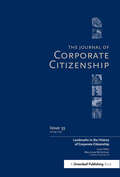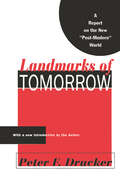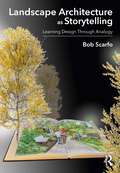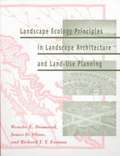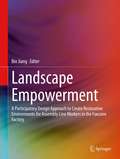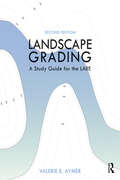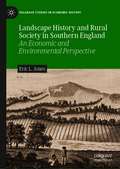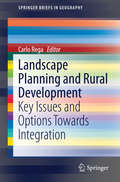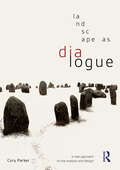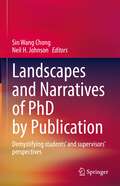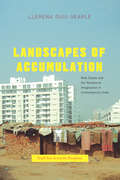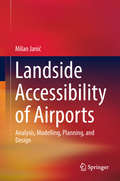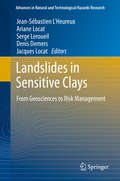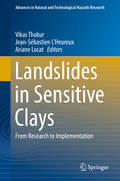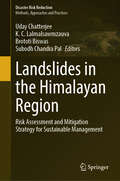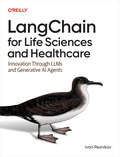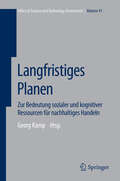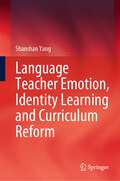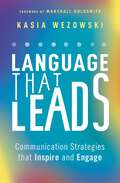- Table View
- List View
Landmarks for Spatial Development: Equality or Differentiation (Contributions to Regional Science)
by Vikas Kumar André Torre Evgeny Kuzmin Yuliya Lavrikova Stanislav MartinatThe book explores the uneven spatial distribution of territory resources and its implication for the sustainable development of regions and cities. The authors analyze the features of the localization of assets, paying attention to both the manifested factors and the conditions that determine the specificity of the current spatial organization. On the basis of multivariate analysis, gravity models, clustering method, as well as the evaluation of concentration parameters, the authors propose various approaches to systematize territorial units, paying special attention to the peculiarities of their economic structure, resource diffusion barriers, and quality of life parameters. The obtained results indicate the need for a differentiated approach in the choice of guidelines for the transformation of the socio-economic space, allowing the researchers to propose various transformation models for differing regions. Thus, this book presents spatial organization models for different regional economies, highlighting various approaches to achieving the Sustainable Development Goals and reducing inequality. The book seeks to balance the benefits of polarized development with the need to avoid significant interregional disparities. At the same time, the book offers various solutions for differentiating territories, distinguishing different spatial elements, and determining the most appropriate transformation options. The results obtained may be of interest to scholars in regional and spatial science as well as to professionals in the field of territorial development management.
Landmarks for Sustainability: Events and Initiatives That Have Changed Our World
by Wayne VisserLandmarks for Sustainability is a high-impact, quick-reference guide to many of the most critical events and initiatives that have shaped our world, and the sustainable development agenda, over the past 20 years and more. These include high-profile historic events – such as the Exxon Valdez oil spill, the Rio Earth Summit, the anti-globalisation protests in Seattle and Genoa and the collapse of Enron – as well as more subtle but no less important developments, such as trends in fairtrade, ethical codes and sustainable investment. By shining a spotlight on these and other landmark events and initiatives, the book draws into sharp relief the most significant social and environmental challenges of our time – from climate change and the state of the planet to poverty and corruption. Equally importantly, however, more than half of the book is dedicated to constructive global responses, such as the boom in clean technology, the role of the World Economic and World Social Forums, and the growth of ISO 14001 and SA8000 standards. Each of the 20 chapters follows a similar easy-access full-colour design, with inspiring quotations, compelling photographs, a timeline of associated events, a narrative description of trends, and spotlight features of specific initiatives or events, including charts, factboxes and suggestions for further reading and websites. Also included is the world's most comprehensive sustainability timeline, listing and dating 190 key sustainability-related events and initiatives that occurred between 1919 and 2008. All these features combine to make the book an essential and highly accessible resource for managers, teachers, students, government officials, consultants and activists alike. For the first time, these crucial change agents will have a single-source reference book, which is not only packed with useful facts and figures, but is also fascinating to look at and full of inspirational material.
Landmarks in the History of Corporate Citizenship: A special theme issue of The Journal of Corporate Citizenship (Issue 33)
by Malcolm McIntoshThis is not a definitive history of corporate citizenship but for anyone interested in the who, what, why and how of this subject there are some very significant papers which may become definitive for scholars and reflective practitioners. Just as many people cannot imagine a world without mobile telephony and the Internet, and seem not to care or wonder how we got here, so too it is forgotten that much that is now taken for granted in terms of corporate reporting and accountability has been, and still is, the result of a hard struggle.
Landmarks of Tomorrow: A Report on the New Post Modern World
by Peter DruckerLandmarks of Tomorrow forecasts changes in three major areas of human life and experience. The first part of the book treats the philosophical shift from a Cartesian universe of mechanical cause to a new universe of pattern, purpose, and process. Drucker discusses the power to organize men of knowledge and high skill for joint effort and performance as a key component of this change. The second part of the book sketches four realities that challenge the people of the free world: an educated society, economic development, the decline of government, and the collapse of Eastern culture. The final section of the book is concerned with the spiritual reality of human existence. These are seen as basic elements in late twentieth-century society.In his new introduction, Peter Drucker revisits the main findings of Landmarks of Tomorrow and assesses their validity in relation to today's concerns. It is a book that will be of interest to sociologists, economists, and political theorists.
Landscape Architecture as Storytelling: Learning Design Through Analogy
by Bob ScarfoThis book introduces students, practitioners, and laypeople to a comfortable approach to learning landscape architectural design free of design jargon and derived from their existing knowledge. A step-by-step process has readers consider their knowledge of language as metaphorically related to basic design and landscape design. Through information delivery and questioning processes, readers build on what they already know, their tacit understanding of language as applied to problem solving and storytelling. Everyone is a storyteller. Taken one step at a time through a three-tiered analogy of language, basic design, and landscape design, readers learn the makeup and role of such design features as points, lines, planes, volumes and sequential volumetric spaces that make up their worlds. With that, in a sense, new world view, and numerous questions and examples, readers begin to see that they in fact daily read the environments in which they live, work, play, raise families, and grow old. Once they realize how they read their surroundings they are helped to recognize that they can build narratives into their surroundings. At that point the existence of authored landscape narratives finds readers understanding a design process that relies on the designer-as-author, landscape-as-text, and participant, user-as-reader. That process has the reader write a first- or second-person narrative, visually interpret the written narrative into a storyboard, and turn the storyboard into a final design, the physical makeup of which is read by those who participate in it.
Landscape Ecology Principles in Landscape Architecture and Land-Use Planning
by Richard T. T. Forman Thomas C. Brown David M. Gillilan Wenche E. Dramstad James D. Olson Richard T. Forman Harvard University Graduate School of Design Staff Wenche DramstadLandscape ecology has emerged in the past decade as an important and useful tool for land-use planners and landscape architects. While professionals and scholars have begun to incorporate aspects of this new field into their work, there remains a need for a summary of key principles and how they might be applied in design and planning. This volume fills that need. It is a concise handbook that lists and illustrates key principles in the field, presenting specific examples of how the principles can be applied in a range of scales and diverse types of landscapes around the world. Chapters cover: patches -- size, number, and location edges and boundaries corridors and connectivity mosaics summaries of case studies from around the world
Landscape Empowerment: A Participatory Design Approach to Create Restorative Environments for Assembly Line Workers in the Foxconn Factory
by Bin JiangThis book discusses essential strategies and approaches to creating mentally restorative environments for highly stressed and depressed workers at sweatshop factories. Drawing on the Foxconn factory in Longhua, China and an adjacent urban village as a sample site for research and design practice, the book employs a bottom-up and participatory process. The content is divided into two main parts, the first of which investigates economic, cultural, human rights, and environmental issues related to the electronic industry and urban village, providing in-depth research on various aspects, especially the working and living conditions for Foxconn workers. Based on these findings, the second part highlights potential landscape designs to address a range of issues, locations, and scales. The book’s goals are to provide a set of original methods for research and design practice in a complex social and economic context, and to raise awareness regarding the health, dignity and freedom of millions of workers.
Landscape Grading: A Study Guide for the LARE
by Valerie E. AymerFor every element that we design in the landscape, there is a corresponding grading concept, and how these concepts are drawn together is what creates a site grading plan. This study guide explores these concepts in detail to help you learn how to grade with confidence in preparation for the Grading, Drainage and Construction Documentation section of the Landscape Architecture Registration Examination (LARE). This updated second edition is designed as a textbook for the landscape architecture student, a study guide for the professional studying for the LARE, and a refresher for licensed landscape architects. New to this edition: • Additional illustrations and explanations for grading plane surfaces and warped planes, swales, berms, retention ponds, and drain inlets; • Additional illustrations and explanations for grading paths, ramp landings, ramp/stair combinations and retaining walls; • A section on landscape and built element combinations, highlighting grading techniques for parking lots, culverts and sloping berms; • A section on landscape grading standards, recognizing soil cut and fill, determining pipe cover, finding FFE, and horizontal and vertical curves; • Updated information about the computer-based LARE test; • All sections updated to comply with current ADA guidelines; • An appendix highlighting metric standards and guidelines for accessibility design in Canada and the UK. With 223 original illustrations to aid the reader in understanding the grading concepts, including 32 end-of-chapter exercises and solutions to practice the concepts introduced in each chapter, and 10 grading vignettes that combine different concepts into more robust exercises, mimicking the difficulty level of questions on the LARE, this book is your comprehensive guide to landscape grading.
Landscape History and Rural Society in Southern England: An Economic and Environmental Perspective (Palgrave Studies in Economic History)
by Eric L. JonesThis book applies an economic and environmental perspective to the history of landscape and the rural economy, highlighting their inter-connections through specific case studies. After explaining how the author made his discoveries and when they started, it analyses relations between documentary and landscape evidence. It is based on exceptional first-hand observation of a dozen sites and close consideration of topics in the ecological and economic history of southern England. They range from reclaiming chalk down-land, occupying low-lying heaths and reconstructing parkland, to wool-stapling and the manufacture of gunstocks for the African slave trade. Additional themes include the tension between ecology and institutions in decisions about the location of economic activity; the decay of communal farming ahead of enclosure; and other interesting puzzles in rural economic history. This book offers an original approach to questions in economic history through its synthesis of different types of evidence. It will be of interest to a diverse range of readers because it addresses how economic change was registered in the landscape, and how that change was influenced by landscape. It is a book with highly original features, contributing simultaneously to economic, agricultural, environmental, and landscape history.
Landscape Planning and Rural Development
by Carlo RegaThis book aims to contribute to the current debate on how to integrate rural development policies and landscape planning in rural areas. It highlights the key issues at stake and the possibilities for synergies between landscape planning and policies in light of European development policies, particularly the EU's Rural Development Policy and the Common Agricultural Policy (CAP). Case studies from different rural contexts and landscapes are provided, illustrating tools and options to make the advocated integration operational. Recommendations and guidance to policy making are proposed. The case studies presented cover 1) the use of visual assessment techniques to support landscape planning in rural areas; 2) participative applications of landscape assessment techniques in peri-urban areas; 3) multi-scale approaches to landscape management in Alpine areas and 4) the application of landscape economic evaluation to foster rural development strategies.
Landscape and Change in Early Medieval Italy
by Paolo SquatritiThis innovative environmental history of the long-lived European chestnut tree and its woods offers valuable new perspectives on the human transition from the Roman to the medieval world in Italy. Integrating evidence from botanical and literary sources, individual charters and case studies of specific communities, the book traces fluctuations in the size and location of Italian chestnut woods to expose how early medieval societies changed their land use between the fourth and eleventh centuries, and in the process changed themselves. As the chestnut tree gained popularity in late antiquity and became a valuable commodity by the end of the first millennium, this study brings to life the economic and cultural transition from a Roman Italy of cities, agricultural surpluses and markets to a medieval Italy of villages and subsistence farming.
Landscape as Dialogue: A New Approach to Site Analysis and Design
by Cory ParkerLandscape as Dialogue redefines the process of understanding landscapes for students and practitioners so they can create more integrated, healthy places. Traditional site analysis sees the landscape as a series of components, evaluated individually, before being put back together. This perpetuates existing social hierarchies, maintains the need for high energy inputs and trumpets iconic designs that contribute to gentrification. This book examines the process of landscape dialogue as a natural give and take with the environment, drawing on diverse and challenging writings from design, geography, philosophy and ecological sciences to probe the relationship between humans and landscape. Each chapter begins with a discussion of a theoretical approach to landscape dialogue, such as perception, information or critique, before offering a series of practical steps and representation techniques that designers can use in understanding the landscape. Detailed illustrated case studies from around the world, including Hawaii, the American Southwest, Japan, China, Mexico, Turkey and Peru, explore the book’s lessons in practice. This must-read book offers a radical alternative to conventional analytical approaches, inspiring designers to fully engage in the landscape to ultimately generate ecologically considered places.
Landscapes and Narratives of PhD by Publication: Demystifying students’ and supervisors’ perspectives
by Sin Wang Chong Neil H. JohnsonThis book includes theoretical, conceptual, empirical, and reflective discussions on issues and experiences pertaining to PhD by Publication for both the prospective and retrospective route. It features formal work alongside reflections on stakeholders’ experiences and addresses formal primary research and research syntheses which survey the landscapes of PhD by Publication regarding its policies, thesis and student experience. The book provides personal, context-specific and in-depth insider’s perspectives towards PhD by Publication and offers a holistic understanding of micro- and macro-level issues by offering research and personal insights.'Despite being in existence for over 20 years, the route to PhD is still often poorly understood by individuals and institutions. This lively, personal, informative, and affirming text will change that. Recognising the value and expansion of the route to a PhD by publication, and the current lack of published advice, Chong and Johnson have drawn together accounts by supervisors, student and graduates of their experiences of PhDs by publication, and what they learnt that will make the journey easier for others. Containing advice about how to apply, how to select publications, and how to prepare for the viva, it will be a valuable handbook for students and supervisors alike. Full of insights that will resonate with many research students and supervisors, and not only those involved in the ‘by publication’ route, it will help with tackling perennial barriers such as finding time to write, managing ‘imposter syndrome;’, and addressing the loneliness that many PhD student experience. An immensely useful, direct, profound and inspiring collection.'Professor Shân Wareing, Deputy Vice Chancellor, University of Northampton
Landscapes of Accumulation: Real Estate and the Neoliberal Imagination in Contemporary India (South Asia Across the Disciplines)
by Llerena Guiu SearleOver the past few decades, India has experienced a sudden and spectacular urban transformation. Gleaming business complexes encroach on fields and villages. Giant condominium communities offer gated security, indoor gyms, and pristine pools. Spacious, air-conditioned malls have sprung up alongside open-air markets. In Landscapes of Accumulation, Llerena Guiu Searle examines India's booming developments and offers a nuanced ethnographic treatment of late capitalism. India's land, she shows, is rapidly transforming from a site of agricultural and industrial production to an international financial resource. Drawing on intensive fieldwork with investors, developers, real estate agents, and others, Searle documents the new private sector partnerships and practices that are transforming India's built environment, as well as widely shared stories of growth and development that themselves create self-fulfilling prophecies of success. As a result, India's cities are becoming ever more inaccessible to the country's poor. Landscapes of Accumulation will be a welcome contribution to the international study of neoliberalism, finance, and urban development and will be of particular interest to those studying rapid--and perhaps unsustainable--development across the Global South.
Landside Accessibility of Airports: Analysis, Modelling, Planning, And Design
by Milan JanićThis book covers the analysis, modelling, planning, and design of airport landside access modes and their systems. It elaborates on the issues and related problems of airport landside accessibility in an innovative, comprehensive and systematic way. In addition to the general concept of accessibility, the book addresses the analysis and modelling of infrastructure-related, technological, operational, economic, social and environmental performance of road- and rail-based transport systems, as well as the core principles of their planning and design. The book provides guidelines on the modelling, planning, and design of airport landside access modes and their systems, which will contribute to the overall sustainable development of airports. Its main features are: presents a multidimensional examination of performance for specific airport landside access modes and their systems; pursues a qualitative and quantitative approach to developing performance indicators for estimating the sustainability of airport landside access modes and their systems; includes illustrative cases of airport landside accessibility, and numerical examples as exercises for assessing performance using the systems’ indicators. As such, the book offers a valuable source of information for all practitioners involved in analysing, planning and designing more environmentally friendly airport access modes and systems, and who want to learn how to overcome the issues and problems surrounding landside accessibility. It will also benefit students studying the analysis and modelling of transportation systems, and researchers seeking to promote improved sustainability at airports.
Landslides in Sensitive Clays
by Jean-Sébastien L'Heureux Ariane Locat Serge Leroueil Denis Demers Jacques LocatLandslides in sensitive clays represent a major hazard in the northern countries of the world such as Canada, Finland, Norway, Russia, Sweden and in the US state of Alaska. Past and recent examples of catastrophic landslides at e. g. Saint-Jean-Vianney in 1971, Rissa in 1979, Finneidfjord in 1996 and Kattmarka in 2009 have illustrated the great mobility of the remolded sensitive clays and their hazardous retrogressive potential. These events call for a better understanding of landslide in sensitive clay terrain to assist authorities with state-of-the-art hazard assessment methods, risk management schemes, mitigation measures and planning. During the last decades the elevated awareness regarding slope movement in sensitive clays has led to major advances in mapping techniques and development of highly sophisticated geotechnical and geophysical investigation tools. Great advances in numerical techniques dealing with progressive failure and landslide kinematic have also lead to increase understanding and predictability of landslides in sensitive clays and their consequences. This volume consists of the latest scientific research by international experts dealing with geological, geotechnical and geophysical aspects of slope failure in sensitive clays and focuses on understanding the full spectrum of challenges presented by landslides in such brittle materials.
Landslides in Sensitive Clays
by Ariane Locat Vikas Thakur Jean-Sébastien L’heureuxThis book gathers the most recent scientific research on the geological, geotechnical and geophysical aspects of slope failure in sensitive clays. Gathering contributions by international experts, it focuses on understanding the complete and practical spectrum of challenges presented by landslides in such complex materials. Based on sound and validated research results, the book also presents several recommendations that could be implemented in the guidelines or code-of-practice. These recommendations cover topics including the characterization and behavior of sensitive clays; the pre-failure, failure and post-failure stages of sensitive clays; mapping and identification methods; climate change; hazard assessment; and risk management. Sensitive clays are known for their potential for causing large landslides, which pose a serious risk to human lives, infrastructure, and surrounding ecosystems within their reach. This has been demonstrated by the recent catastrophic landslides in e. g. S#65533;rum (2016), Skjeggestad (2015), Statland (2014), Byneset (2012), St-Jude (2010), Lyngen (2010) and Kattmarka (2009). The 2015 collapse of the Skjeggestad Bridge in Norway - which was due to a landslide in sensitive clay - alone costs millions of dollars in repairs. Recently, efforts are being made to increase society's ability to cope with such landslide hazards. Geoscientists are now expected to provide input to the agencies responsible for landslide-risk preparedness. In other words, geoscientists' role is not only to act as technologists to establish new theories, but also to go the extra mile to implement them in practice, so as to find meaningful solutions to geotechnical problems.
Landslides in the Himalayan Region: Risk Assessment and Mitigation Strategy for Sustainable Management (Disaster Risk Reduction)
by Uday Chatterjee K. C. Lalmalsawmzauva Subodh Chandra Pal Brototi BiswasThis book explores a platform for insightful discussions and scientific discourse on various aspects of landslides and their risk management, with insights focused on the Himalayan states at a sub-regional level. A fundamental reference is thus provided for further research not only in landslides but also in associated natural hazards. The book is divided into four major parts, starting from conceptual models in approaching landslide risk, followed by evaluation of risk, management of landslide risk, end-to-end solutions for landslide risk assessment, and a synopsis. Included are topics such as the nature of landslide hazard impact, scale dependency in landslide hazard and risk analysis, and systematic procedures of landslide hazard mapping for risk assessment using spatial prediction models. The book also covers such important aspects as the response of the insurance industry to landslide risk and the role of administrative bodies in landslide risk assessment and sustainable management. Readers gain ample knowledge through case studies regarding the types of landslides in the Himalayan region, which will help them in their future research hypotheses.
LangChain for Life Sciences and Healthcare: Innovation Through LLMs and Generative AI Agents
by Ivan ReznikovFeeling overwhelmed by the volume of data in your research? Sifting through massive amounts of data to find useful insights is becoming increasingly difficult in drug discovery, genetics, and healthcare. Enter the era of generative AI with LangChain, whose groundbreaking tools are changing the way life scientists and researchers operate. In this groundbreaking book, Dr. Ivan Reznikov teaches you to harness the power of AI to elevate your research capabilities. Divided into two parts, the first is essential for any specialist, covering the transition from traditional statistics to generative AI, the fundamentals of large language models, and the practical uses of LangChain. The second part is designed for life science professionals who want to create AI applications for biology, chemistry, drug development, and more. By the end, you will: Learn how to easily create and integrate LangChain applications into research Discover how to substantially accelerate your experimental and data analysis operations Explore cutting-edge AI solutions designed to address complex research problems Gain the skills and knowledge to advance your career in AI-enhanced life sciences
Langfristiges Planen
by Georg KampDas Projekt entwickelt einheitliche methodologische Grundlagen für eine langfristige Planung, deren Umsetzung die Nachhaltigkeit des individuellen wie des gesellschaftlichen Handelns möglichst verlässlich sichert. Die Arbeitsplanung folgt dem bewährten Projektgruppenprinzip der ,,Europäischen Akademie". Dabei erarbeitet eine interdisziplinär zusammengesetzte Projektgruppe gemeinsam Lösungen zu einem definierten Themenbereich. Eine inhaltliche Präzisierung des Programms erfolgt zunächst durch die sogenannte Kerngruppe. In dieser sind Experten aus den wissenschaftlichen Disziplinen Nachhaltigkeitsökonomik, experimentelle Ökonomik, Ethik/praktische Philosophie, Politikwissenschaft beziehungsweise Institutionentheorie vertreten. Zur intensiven Bearbeitung des präzisierten Programms wird die Projektgruppe um Vertreterinnen und Vertreter aus weiteren einschlägigen Disziplinen erweitert. Diese Disziplinen können sein: Soziologie, Rechtswissenschaft, Wissenschaftstheorie und Governanceforschung. In insgesamt elf Gruppensitzungen und zwei Evaluierungskonferenzen sowie einzelthemenbezogenen Fachgesprächen und Workshops entwickeln die Projektgruppenmitglieder ausgehend von disziplinär erstellten Textvorlagen eine von allen mitgetragene Studie. Mit dieser Herangehensweise werden zugleich eine Erweiterung des methodischen Instrumentariums der Nachhal-tigkeitsökonomik sowie insgesamt eine Verbesserung des Planens, Entscheidens und Handelns in nachhaltigkeits - ökonomischen Zusammenhängen angestrebt.
Language Research in Multilingual Settings: Doing Research Knowledge Dissemination at the Sites of Practice (Communicating in Professions and Organizations)
by Lubie Grujicic-AlatristeThis book describes the steps undertaken by language researchers to disseminate their findings at sites of practice. It discusses questions that arise from such efforts and provides meaningful, real-life, first-hand accounts of both interactions with practitioners and practitioners’ feedback. The authors use narrative accounts, case studies, and semi-ethnographies of focus groups and workshops to draw a full picture of dissemination, its intricacies, multiple stakeholder interests, reflexivity challenges, and future relevance and responsibility for all parties involved. It is an attempt to fill the gap between the end of research domains and the places of dissemination of research findings, and the book will be of interest to applied linguistics researchers, students and scholars of organisational discourse, and practitioners working in multilingual settings.
Language Teacher Emotion, Identity Learning and Curriculum Reform
by Shanshan YangThis book explores language teachers' identity learning through the lens of teacher emotions. This qualitative study, utilizing a longitudinal case study design, sets out to trace how four college English teachers at the case study university in East China respond emotionally towards the curriculum reform, how teacher identity learning takes place, and how emotions interact with the identity learning processes. Guided by the theoretical framework, this book adopts diversified methods to collect data across one academic year of curriculum implementation. It also discusses the findings which reveal that curriculum reform poses great emotional challenges for English as a Foreign Language (EFL) teachers, teachers who traverse across emotional geographies, orient to feeling rules, and perhaps translate emotion work into emotional capital. This book explores language teachers' identity learning.This book helps the researchers, policymakers, and other stakeholders involved in higher education policymaking to understand how EFL teacher emotions can be utilized to support EFL teachers' identity learning and thus sustain curriculum reform efforts.
Language That Leads: Communication Strategies that Inspire and Engage
by Kasia WezowskiInspire and motivate your team using powerful verbal and nonverbal communication strategies.Today&’s leaders need to use effective, empathetic communication to bring out the best in their team members and let each individual shine.Kasia Wezowski, a leading researcher on body language and communication skills, combines her cutting-edge research with Marshall Goldsmith&’s leadership development methodology in this practical and timely resource for leaders. Goldsmith believes that a leader&’s job is to bring out the best in each team member and Language That Leads breaks down the ten core qualities of leadership, providing easy-to-follow implementation steps to express, observe, and project these qualities effectively through verbal and nonverbal communication.In these pages, readers will learn:How to integrate adaptability, empathy, engagement, and transparency in interpersonal communication.How to cultivate courage, discipline, and integrity in order to build self-trust and garner trust from others.How to develop humility, positivity, and purpose in order to be a quietly powerful role model to team members.How to transform oneself internally to embody these ten qualities and empower others to do the same.
Language and Development in Africa
by H. Ekkehard WolffDevelopment is based on communication through language. With more than two thousand languages being used in Africa, language becomes a highly relevant factor in all sectors of political, social, cultural and economic life. This important sociolinguistic dimension hitherto remains underrated and under-researched in 'Western' mainstream development studies. The book discusses the resourcefulness of languages, both local and global, in view of the ongoing transformation of African societies as much as for economic development. From a novel 'applied African sociolinguistics' perspective it analyses the continuing effects of linguistic imperialism on postcolonial African societies, in particular regarding the educational sector, through imposed hegemonic languages such as Arabic and the ex-colonial languages of European provenance. It offers a broad interdisciplinary scientific approach to the linguistic dimensions of sociocultural modernisation and economic development in Africa, written for both the non-linguistically trained reader as much as for the linguistically trained researcher and language practitioner.
Language and Globalization: "Englishnization" at Rakuten (A)
by Tsedal NeeleyHiroshi Mikitani, the CEO of Rakuten, (Japan's largest online retailer), is at the helm of an organization that is rapidly expanding into global markets. In a critical stride toward becoming the world's No. 1 Internet services company, Mikitani announces Englishnization - a highly publicized aggressive two-year English proficiency mandate for all 7,100 of Rakuten's Japanese employees. Mikitani's goal is not only to ensure the success of the organization, but also to break down linguistic and cultural boundaries in Japanese society. At the time, only an estimated 10% of the Japanese staff could function in English. The stakes are high: those who do not reach their target score by the deadline risk being demoted. As Englishnization progresses, loss of productivity, lack of time to study, and conflicted views among managers impede staff success. Some employees even question the relevance of Englishnization, particularly for staff working exclusively in Japan. Fifteen months since the announcement, the vast majority had not yet reached their target English proficiency scores. With the deadline rapidly approaching, Mikitani must decide how to proceed to ensure the success of Englishnization, the continued global rise of his organization, and even the future of Japan.


